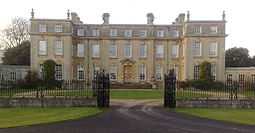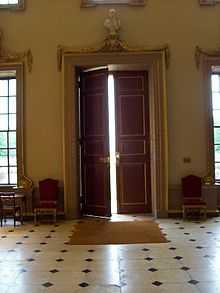Ditchley

Ditchley is a country house and estate near Charlbury in Oxfordshire.
The estate was once the site of a Roman villa, whose location was identified from the air. Later it became a royal hunting ground, and then the property of George Lee, 2nd Earl of Lichfield, who built the present house, designed by James Gibbs, in 1722.
In 1933, the house was bought by an MP, Ronald Tree, whose wife Nancy Lancaster redecorated it in partnership with Sibyl Colefax. During the war, they allowed their friend Winston Churchill to use the house as his country retreat, as it was hard to spot from the air.
Later, Tree sold Ditchley to Sir David Wills of the tobacco family, who set up the Ditchley Foundation, for the promotion of international relations.
Archaeology
There are remains of a Roman villa on the Ditchley Park estate at Watts Wells, less than 1 mile (1.6 km) southeast of the house.[1] It was a colonnaded house with outbuildings, threshing floors, and a granary with capacity for the produce of about 1,000 acres (400 ha) of arable land.[2] It was surrounded by a rectangular ditch 360 yards (330 m) by 330 yards (300 m).[3] The site is less than 2 miles (3.2 km) north of the course of Akeman Street Roman road, and is one of a number of Roman villas and Romano-British farmsteads that have been identified in the area,[4] apparently associated with the territory bounded by Grim's Ditch.[5]
The villa site was identified by aerial archaeology in 1934 and excavated in 1935.[6] It was found to have been first settled in about AD 70 with a set of timber-framed buildings, which were replaced in stone in the 2nd century.[6] In about AD 200 a fire severely damaged the stone buildings and the site was abandoned.[6] The site was reoccupied early in the 4th century, and occupation on a more modest scale than before continued until the end of that century.[6]
Some time before the villa was discovered and excavated, a hoard of 1,176 bronze Roman coins was found between Box Wood and Out Wood, about 600 yards (550 m) to 700 yards (640 m) northeast of the villa site.[7] The coins range in date from about AD 270 onwards and seem to have been buried in a ceramic pot about AD 395, towards the end of the Roman occupation.[8] The hoard was transferred to the Ashmolean Museum in Oxford in 1935.[7]
Grim's Ditch, which passes through the present park and estate, is an ancient boundary believed to have been constructed during the Roman occupation of Britain in about the 1st century AD.[9] The toponym "Ditchley" is derived from a compound of two Old English words, meaning the woodland clearing ("-ley") on Grim's Ditch.
History

Once the royal hunting ground of Wychwood Forest,[10] the site was first occupied by a timber-framed structure which was constructed for Hancock Lee but which later burnt down. In September 1603 James I dined with Sir Henry Lee at Ditchfield.[11] The present house was erected in 1722 for George Lee, 2nd Earl of Lichfield and was designed by James Gibbs.
Occupants of the Ditchley estate have included:
- Sir Francis Lee, 4th Baronet of Quarendon
- Charlotte Lee, Countess of Lichfield, illegitimate daughter of Charles II
- Viscounts Dillon
Tree family

In 1933 after the death of the 17th Viscount Dillon, Ditchley was bought by Anglo-American Ronald Tree and his wife, the celebrated decorator Nancy Lancaster. It was the decoration of Ditchley which earned Nancy the reputation of having "the finest taste of almost anyone in the world." She worked on it with Lady Colefax (Mrs Bethell of Elden Ltd having died in 1932) and the French decorator Stéphane Boudin of the Paris firm Jansen.
In November 1933 Ronald was elected MP for Harborough, Leicestershire. Tree and his wife Nancy were among those who saw the Nazi threat, and had invited Winston Churchill and his wife to dinner on numerous occasions from 1937.
Churchill

On the outbreak of war, the security forces were concerned by the visibility of both Churchill's country house Chartwell - its high geographic location, and the fact it was south of London, making it an easy returning-home target for German aircraft - and the Prime Minister's retreat of Chequers, which had an entrance road which was clearly visible from the sky. Churchill had use of the Paddock bunker in Neasden, but only used it on one occasion for a cabinet meeting, before returning to his Cabinet War Room bunker in Whitehall. However, this created additional difficulties on clear nights when a full moon was predicted - so the authorities looked for an alternative site north of London.
Tree offered Churchill the use of Ditchley, which thanks to its heavy foliage and lack of a visible access road made it an ideal site. Churchill first went to Ditchley in lieu of Chequers on 9 November 1940, accompanied by Clementine and his daughter Mary. During visits to Ditchley, Churchill negotiated part of the Lend-Lease agreement with United States Secretary of Defense James Forrestal, and had exiled Czechoslovakian President Edvard Beneš as a guest.[12]
By late 1942, security at Chequers had been improved, notably including covering the road with turf. The last weekend Churchill attended Ditchley as his official residence was Tree's birthday on 26 September 1942. Churchill's last visit was for lunch in 1943[13]
In June 1994, US Secretary of State Warren Christopher and British Foreign Secretary Douglas Hurd unveiled a bronze bust of Churchill, which stands in a prominent position to highlight the role that Ditchley Park played during a critical phase of the Second World War.
Recent decades

Shortly after the end of the war, Tree divorced Nancy and married Marietta Peabody Fitzgerald, an American woman he had met while working for the Ministry of Information. Marietta moved into Ditchley, but found English country life not to her liking. Noticing his wife's upset, and short of money, Tree sold Ditchley to Sir David Wills, descendant of the tobacco importing family, W. D. & H. O. Wills of Bristol; and moved with his family and butler Collins to New York.
In 1958 Wills set up a trust called the Ditchley Foundation, which aims to promote international (especially Anglo-American) relations, and which still owns the house today.
During filming of the 2009 feature film The Young Victoria, Ditchley was used to represent Buckingham Palace, in particular Victoria's sitting room.
Ditchley is sometimes known as Ditchley Park or Ditchley House. It lies about 2 miles (3.2 km) northeast of Charlbury.
See also
- Ditchley Foundation
- Ditchley is also the name of a station on the Victorian Colac to Beech Forest and Crowes narrow gauge railway of Victoria, Australia.
References
- ↑ Sherwood & Pevsner, 1974, page 576
- ↑ Emery, 1974, page 44
- ↑ Riley, 1943, page 87
- ↑ Emery, 1974, pages 41-45
- ↑ Booth, 1999, pages 47-48
- ↑ 6.0 6.1 6.2 6.3 Booth, 1999, page 41
- ↑ 7.0 7.1 Sutherland, 1936, page 70
- ↑ Sutherland, 1936, page 71
- ↑ Copeland, 1988, page 287
- ↑ "The Ditchley Foundation".
- ↑ "Tudorplace.com".
- ↑ Winston Churchill
- ↑ History Lives at Ditchley and Bletchley - The Churchill Centre
Sources
- Booth, Paul (1999). "Ralegh Radford and the Roman Villa at Ditchley: A Review". Oxoniensia (Oxfordshire Architectural and Historical Society) LXIV: 39–49.
- Copeland, Tim (1988). "The North Oxfordshire Grim's Ditch: a Fieldwork Survey". Oxoniensia (Oxfordshire Architectural and Historical Society) LIII: 277–292.
- Emery, Frank (1974). The Oxfordshire Landscape. The Making of the English Landscape. London: Hodder & Stoughton. pp. 44, 124, 125, 127. ISBN 0-340-04301-6.
- Riley, D.N. (1943). "Archaeology from the Air in the Upper Thames Valley". Oxoniensia (Oxford Architectural and Historical Society). VIII-IX: 64–101.
- Sherwood, Jennifer; Pevsner, Nikolaus (1974). Oxfordshire. The Buildings of England. Harmondsworth: Penguin Books. pp. 572–576. ISBN 0-14-071045-0.
- Sutherland, C.H.V. (1936). "A Late Roman Coin-Hoard from Kiddington, Oxon.". Oxoniensia (Oxford Architectural and Historical Society) I: 70–80.
External links
- Ditchley Foundation
- The Ditchley Foundation from the autobiography of Harry Hodson
- Ditchley House in Images of England - architectural details
Coordinates: 51°53′15″N 1°26′03″W / 51.88750°N 1.43417°W